So here is my new design! The Braid Hills Cardigan!
This is the first in a series of designs celebrating my favourite Edinburgh places. Regular readers will know that I’ve mentioned The Braids on this site many times: the view of the city from here is spectacular, and the landscape is gorgeous for a ramble particularly in Spring when the air is heady with the smell of gorse and the sound of skylarks.
The colourway I chose for my sample was inspired by gorse too – Blacker Swan DK. This is a deliciously squooshy light DK / sportweight merino, grown in the Falkland Islands and then processed in Cornwall by the Natural Fibre Company. It is airy and bouncy and, because it is worsted spun, it also has a really smooth hand. All of these characteristics means that when knit up the yarn has great definition, and shows off twisted-stitch cables superbly.
I have recently been on a bit of a cable kick, and have been really inspired by Maria Erlbacher’s classic Überlieferte Strickmuster (available in English from Schoolhouse Press). Because the ‘action’ of these stitches occurs on every row, their look is, I think, particularly neat and sinuous. So pleasing.
Many cables are worked as braids, and as I began swatching various twisted-stitch panels, I was strongly reminded of the braided structure of eighteenth-century laced stays and stomachers.
I thought there might be a way to use braided micro cables to lend structure and focus to a garment . . . without, of course, the attendant damage to one’s rib-cage involved in eighteenth-century corsetry.
The neckline of eighteenth century garments above a laced bodice tends to be low and squarish, framing the the high bust . . .
(Philip Mercier, portrait of Lousia Balfour, 1751)
. . . so this is how I structured my neckline too.
Because of the low neckline, it is important that the cables and ribbing of the neckline sit across the high bust without undue stretching. So I recommend knitting this cardigan with a little positive ease to give a neat neckline – paerhaps 0.5 – 1 in. I am modelling the garment with around an inch of positive ease (31 in bust / 32 in garment). (The pattern includes a detailed sizing table and schematic to enable you to choose the size that’s right for you)
The braided micro cables flow down into the ribbing at the neck and hem, and this intertwined patterning is also echoed on both cuffs . . .
I am fond of these cuffs.
Because this pattern is part of a series inspired by the city in which I’ve lived for the past decade, I have decided to add in a few Edinburgh extras – so the pattern booklet includes a short editorial feature exploring the history and geography of the Braid Hills, as well as a photographic lookbook. If you have a copy of Colours of Shetland, you’ll see that the way I have structured the booklet is very like one of my chapters in that book.
This is a design I’m very pleased with for many reasons, and my cable kick is not quite over yet…
So if you’d like to knit your own Braid Hills cardigan and / or read more about this lovely landscape and how it inspired my design, the booklet is now available!
You can purchase the digital edition of the Braid Hills booklet via Ravelry, or it is available in print (professionally produced in either the EU or US and delivered straight to your door) via Mag Cloud.
Happy knitting!

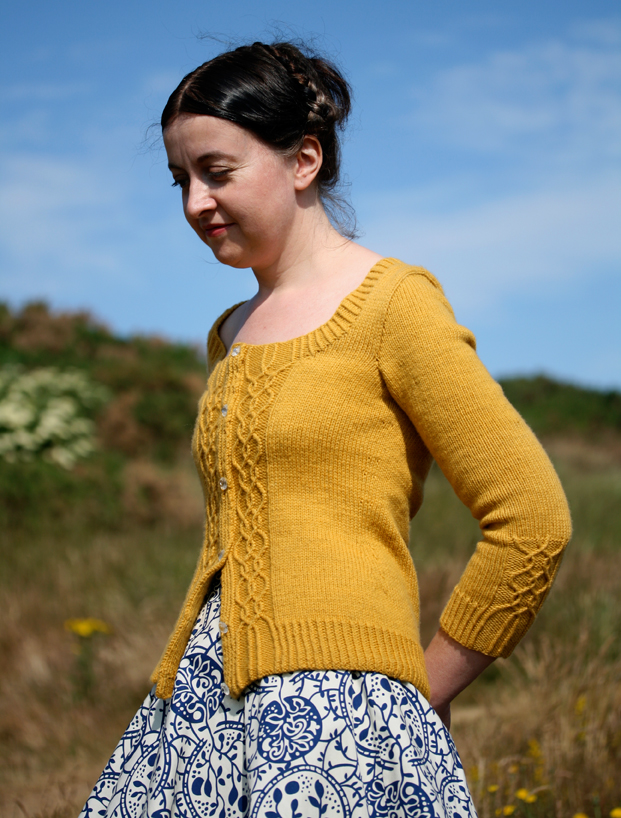
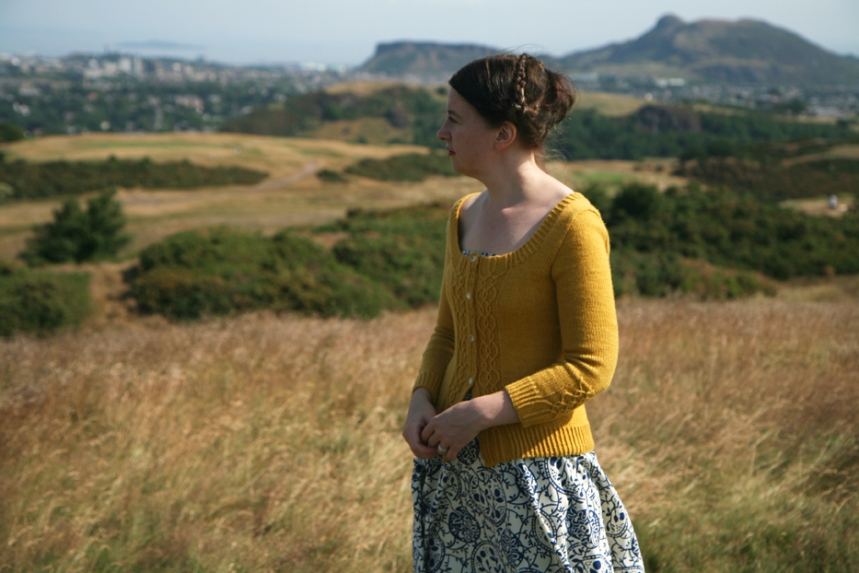
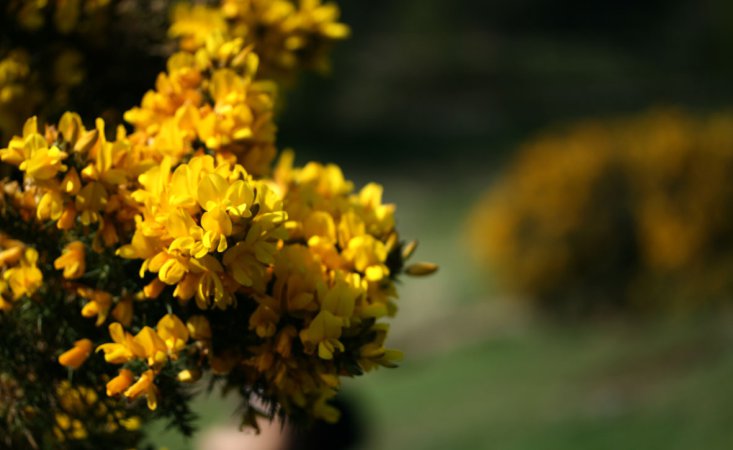
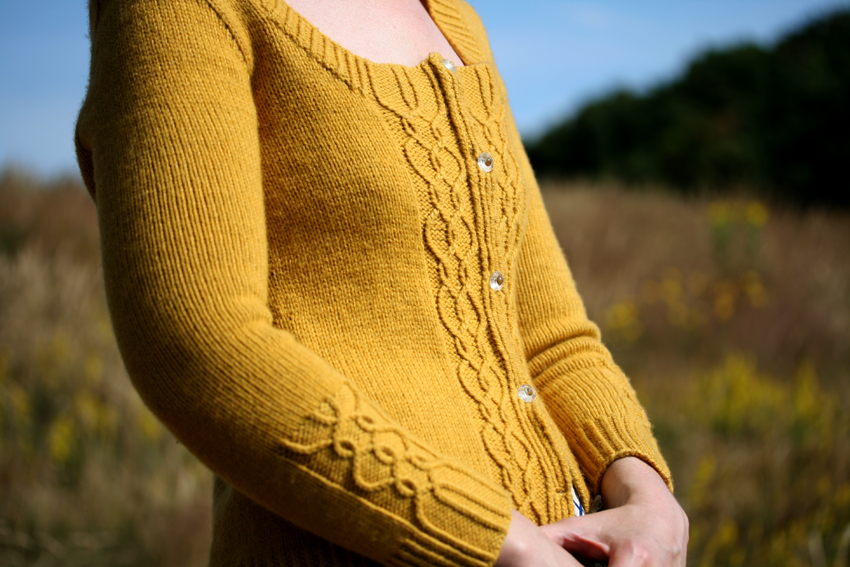
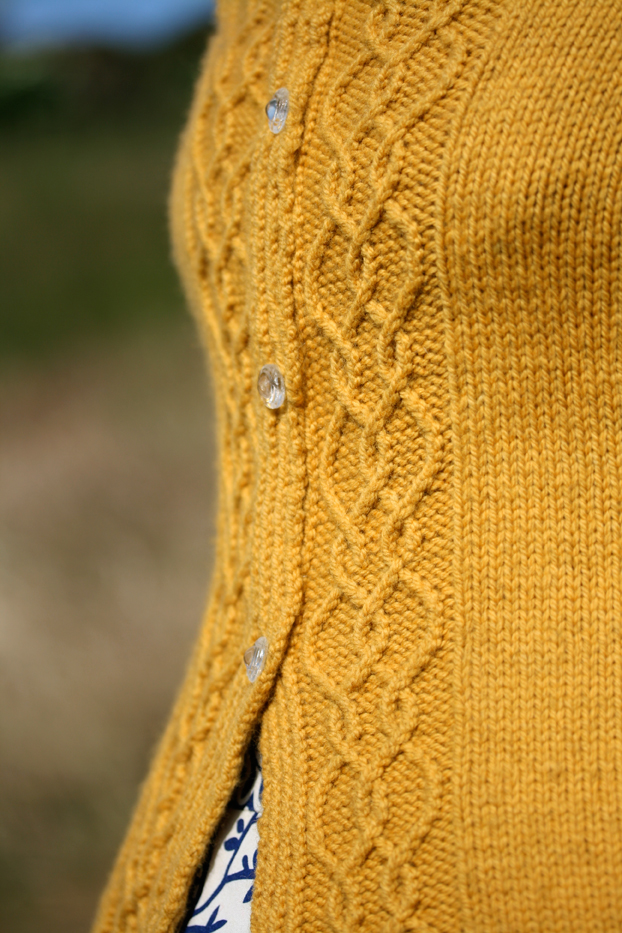



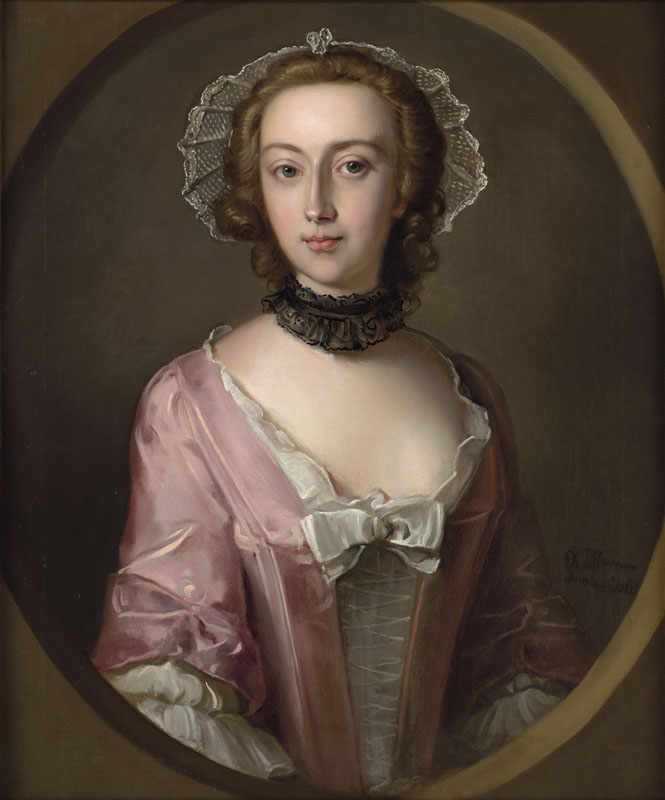

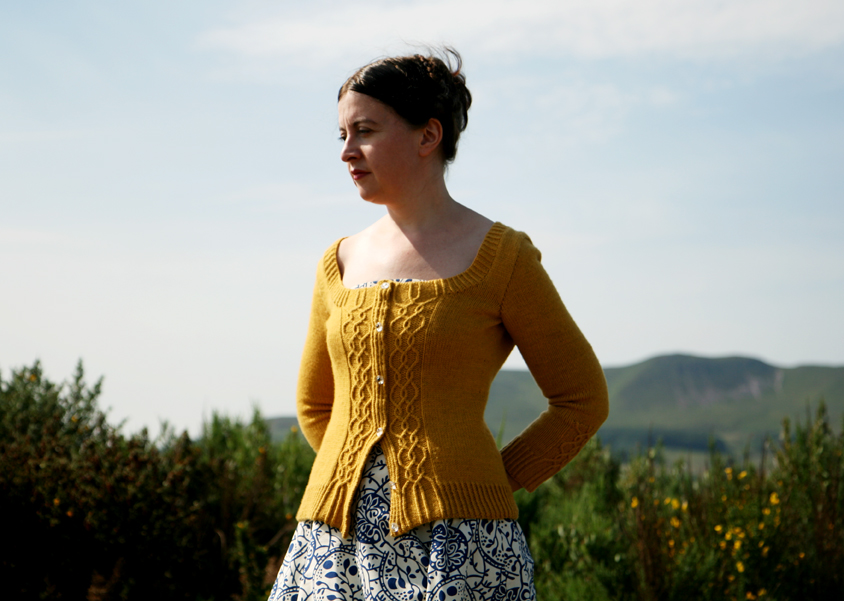
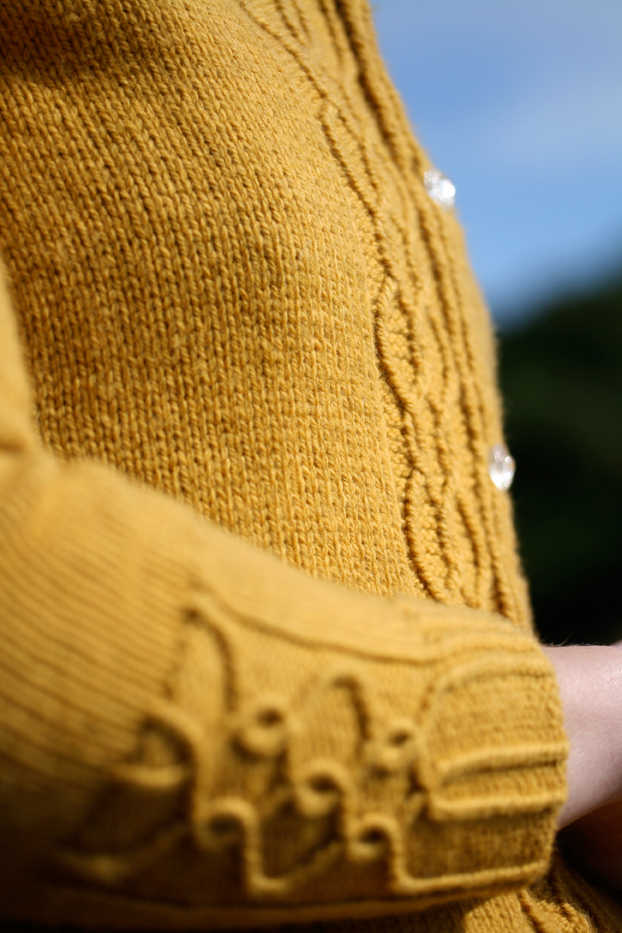


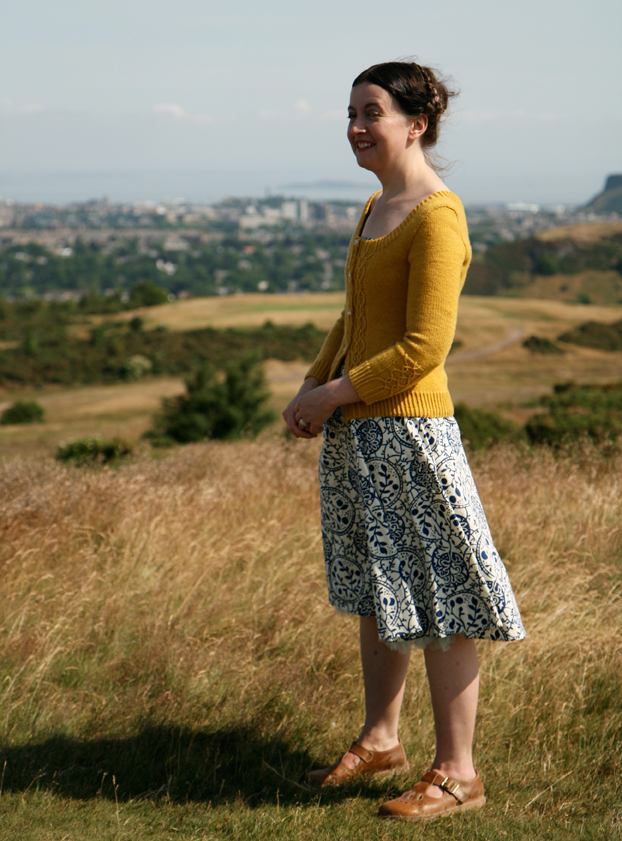
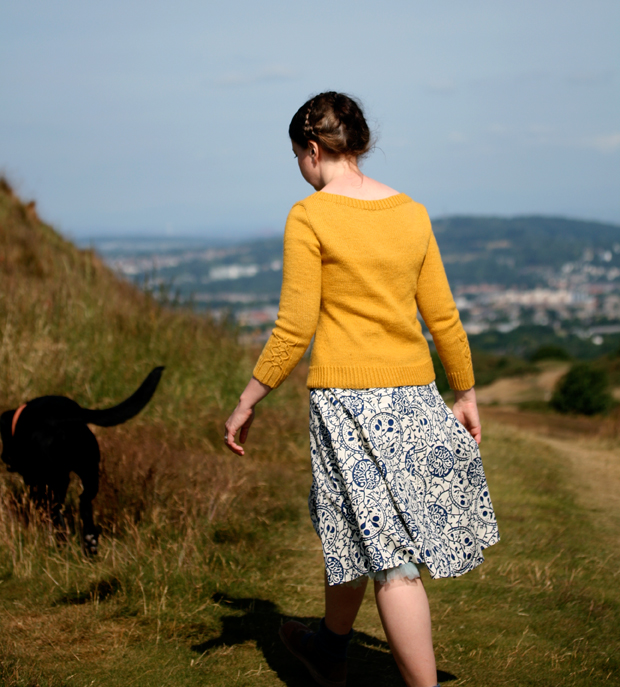


hi Kate
I bought this pattern, with yarn, a couple of years from Purl – a knitting shop in Manchester which no longer exists but struggled to knit it. I understand that you have redesigned it and wondered if it would be possible for me to have a free update for it. I don’t really want to buy it again in case I can’t manage it a second time. I’d be grateful if you would help – I love the design but I feel very frustrated with it at present, and I’d love to be able to say I’d made it and wear it.
best wishes
Karen
LikeLike
Hi Karen – no problem – just email us at info@katedaviesdesigns.com
LikeLike
Beautiful!
LikeLike
I was wondering, do you think this pattern would work with Alpaca? I really love it and have been looking for a while for a pattern with subtle cablework, because I wanted to knit a dark grey alpaca cardigan with little bright pink cables running through it (I know, it’s precise…).
LikeLike
I’m really impressed that you used your period inspiration in such a subtle, non-costumey way. The sweater looks delicate and modern at the same time, and I think mustard was a great choice of color for one that could suggest the 18th century or the present day depending on context.
I’d love to see a picture of this on Kollabora, the crafting and DIY community I’m part of. Not many members seem to have been making cardigans lately, and I miss seeing them.
LikeLike
Totally stunning, I adore and admire your approach towards interpreting historical costume in knit
LikeLike
Oh, the cardigan. Possibly my perfect perfect neckline. But also – oh, the dress. How I love blue & white together like that… Where’s it from??
LikeLike
Absolutely lovely. My eye is immediately drawn to those fabulous cuffs!
LikeLike
Its really beautiful, a work of art. i’m familiar with Braid Hills and love it when a pattern is named in this way. Maybe one day I shall do my own design and name it after my hometown of Auchtermuchty..a name that never fails to catch the eye..lol.
LikeLike
This design touches my heart. I have spent many a day in the beautiful city of Graz in the Austrian County of Steiermark and seen numerous local “Trachten” garments with beautiful cable patterns.
I particularly like the finer ones that form fine lines like the one you picked. They are also often used for the most intricate looking socks. Quite adorable.
Have you delved into German / Austrian Trachten (local traditional costume)?
I will be knitting this in a stone colour as I don’t suit yellow. It is very very becoming in the colour you picked!
Joanne
LikeLike
One more “must-have” cardi! I’m totally in love with your attention to details, those cables, neckline, cuffs..
And the dress you’re wearing is just gorgeous!
LikeLike
Beautiful cardi….
LikeLike
Hi Kate,
After buying Colours of Shetland , falling in love with the shawl in the Rowan book and reading your blog ….I am a fan!!
Lover your patterns.
Bye Miriam (Holland )
LikeLike
It’s a beautiful cardigan. Your pictures made me think of a traditional dress that a friend of mine just had made for herself in Vorarlberg in Austria which has lacing up the front. You can see similar ones here http://pinterest.com/p8ronella/eu-at-vorarlberg/. Katy
LikeLike
It’s been ages since I was in Scotland but this sweater (even if it’s inspired by Edinburg) brought to mind the breathtaking landscape of Glencoe. The delicate braids are lovely and I’m so looking forward to seeing the next in the series. Will you make a single book out of them all in the end?
LikeLike
This design touches my heart. I have spent many a day in the beautiful city of Graz in the Austrian County of Steiermark and seen numerous local “Trachten” garments with beautiful cable patterns.
I particularly like the finer ones that form fine lines like the one you picked. They are also often used for the most intricate looking socks. Quite adorable.
Have you delved into German / Austrian Trachten (local traditional costume)?
I will be knitting this in a stone colour as I don’t suit yellow. It is very very becoming in the colour you picked!
Joanne
LikeLike
I love, love, LOVE your blog , Kate. I always learn something and am inspired. You make me want to know more about the history of clothing – I wonder could you recommend a book for a beginner to this subject to read? Only of the top of your head, of course, don’t waste any knitting or blogging or walking time on it :)
LikeLike
Gorgeous!! Maybe I should make some quilts inspired by the scenery here in the Glorious Scottish Borders!!
LikeLike
Anne, I really think you should do that!
LikeLike
Everything I love in a cardigan, the colours, the cables, the gentleness, the Edinburghness. Can’t wait to save up for wool for it!
LikeLike
Lovely! I really like the way it matches the Scotch broom flowers. the cabling looks very simple to do also. And, as always, your landscape photos are awesome!
LikeLike
Beautiful!!! I just bought my pattern, I will start to knit it in early september….
LikeLike
So lovely! This should spur me on to finish Ursula – did the colour-work by Easter then slowed down. Also have just started Deco, but then…. (The song ‘When the yellow’s on the broom’ sprung to my mind.)
LikeLike
So very beautiful and what a lovely name. You’re so skilled :-)
LikeLike
I love the cardigan and I love the name. I always think of broom when I think of the Braid Hills. The colour is perfect.
LikeLike
It is perfect! I also love the waist curve, is very flattering on you. Since I wear dresses (yours are gorgeous in each photo-shoot), well structured and flattering cardigan are the best, so I’m going to add it to my queue on Ravelry and can’t wait to see the other from the Edinburgh collection :)
LikeLike
Being taken for walks on the Braids as a child is one of my first and happiest memories, and I love broom, a joyful colour. Beautiful cardi.
LikeLike
Splendid, as expected!
LikeLike
I also just love this design. I think squared necklines can look fantastic on many figure types. I know I feel very lovely when I wear them. :)
Well done.
LikeLike
Just beautiful. Love the colour, the history, the details, everything. Congratulatiooooons!!
LikeLike
Such a beautiful cardigan – congratulations!
LikeLike
Dear Kate,
I’m a huge fan of your designs – always simple yet elegant – but this one tops them all. I love the cable (love the bodice inspiration it’s exactly right…), the fit, the colour, it’s simply grand! It does remind me of the Scottish hillside, I love it! Thanks so much for sharing this!
LikeLike
Oh, regardless of age, that would be so elegant knitted in a deep blue and worn with pearls.
LikeLike
Gorgeous design Kate! The photo’s are equally beautiful, as usual.
Reading about the inspiration for this design was very interesting.
I’m looking forward to see the other designs in the mini collection.!
LikeLike
Beautiful–so elegant. I just ordered Braids as well as Paper Dolls. I like the booklets for filing and the PDF’s for printing and following along on the patterns.
LikeLike
Amazing as usual Kate! Always love your designs. That fiber color is just to die for. Don’t get me wrong, I’m still very much intimidated by your sweaters. I have to get a few more under my belt before I try them out. I’ve started a craft blog of my own. There’s nothing on it yet, but you are definitely a big part in the inspiration department.
LikeLike
Beautiful. I love the way the cables appear to sit on the surface of the fabric rather like a couched cord. It has a wonderfully defined appearance. I’m afraid the lowish neckline would not suit me and a blouse underneath would detract from the neat trim outline. But looking forward to seeing the projects as they appear on Ravelry.
One of my ways of keeping myself amused on train journeys is deciding who would paint the other passengers’ portraits. You are an Alan Ramsey subject for sure.
LikeLike
oh my, ‘that’ yellow and ‘those’ cables! beautiful and i am also off to buy it! read the description of corset making and as beautiful as that one is…….i could hardly breath just thinking about it!
i do not feel that age or shape should deter one from making this sweater. looking foreward to your next offerings. cheers
LikeLike
Couldn’t agree more with your last comment.
LikeLike
What gorgeous cabling! I love the cuff detail and the delicate braid, just gorgeous Kate!
LikeLike
this may be one of my favorites so far, its edinburgh roots, its sinous 18th century ness, its gorse color. i was just reading that the buddha’s robes are flame colored for a reason.
LikeLike
You look so lovely in your new sweater! I put it in my favorites on Ravelry ~ think it’s a definite one to knit!
LikeLike
It’s beautiful, Kate! And I love that colour (already have two yellow cardigans though…)
LikeLike
Oh this one is exceptional ! Sweetly romantic and old-worldish and yet it has that dynamic modern signature you always have. Braid Hills gets my standing applause !
LikeLike
This is very elegant. Very. It flatters your figure.
Kudos on the new design.
LikeLike
This is just lovely! I adore blue and white with mustard yellow, one of my favorite color combos!
LikeLike
Another gorgeous cardigan. Congratulations. Always really love and appreciate that you add beautiful imagery and history to the things you do–makes it all even more enjoyable.
LikeLike
Oh I love this pattern! I couldn’t wear it (I am way too top heavy) but I have several nieces who will love this!
LikeLike
Gorgeous, Kate. Congratulations on another lovely design.
LikeLike
Beautiful – love it. Delicate cables are divine and thank you for designing them into a garment. Twitchy sticks are a-coming ;)
LikeLike
Just love everything, the design, the wool, the photos, the history. You really make me want to live in Edinburgh.
LikeLike
This is gorgeous! I’m off to purchase…
LikeLike
I’ve been looking forward to seeing this design since you gave us the preview. The gorse flower colour is lovely and with that braiding coursing up the pattern it made me think straightaway about the Waimakariri River (in NZ) near where I grew up. It’s a braided river, it’s streams twist and run from the southern alps across the Canterbury plains to the sea, not as tidily structured as these lovely knitted ones though. When I knit this it will be doubly special for me. Thanks, it really is superb.
LikeLike
Another beautiful cardigan Kate, I also love your photos and the history behind your designs. Very inspiational. keep up the good work x
LikeLike
Lovely!
LikeLike
That is really nice! Not everyone could wear it. My girlfriend might enjoy it as my first cabling experience.
LikeLike
Ooh I love it, I love it. I have been looking for a fitted cardigan pattern for some felted tweed I have..and you have made exactly what I want. So fitted! With exactly the right neckline. I will buy it!
LikeLike
This is really very, very nice. I love to see it!
LikeLike
Wonderfull as usual :)
LikeLike
Very fetching I say and love the cables. I would like the sleeves a bit longer I think but you look fabulous in the shorter sleeve.
LikeLike
Lovely design – a very elegant testimony to your love of that place!
LikeLike
très joli….. j ai acheté.
LikeLike
That is beautiful, love the colour, wish I was younger and slimmer!
LikeLike
Hi Kate
What a stunning cardigan! I love Maria E’s Twisted Stitches book, there are enough patterns in there to keep me knitting for a lifetime. I made a pair of gloves using this klausner pattern and am still in love with them. As well as the delicate touch of the cable strands being made from a single twisted stitch, rather than a chunky-style cable, it has a lovely sense of space around it that is beautiful in its simplicity. Some of the motifs in the book have so much going on in them with movement at the front and back that they’re quite busy to the eye. And the yellow colour you’ve chosen is stunning too. Am heading over to ravelry to queue right now!
cheers
Jude
LikeLike
you capture my feelings about that stitch pattern exactly.
LikeLike
Really beautiful. I love the way the cables are so well defined. Definitely on my “to do” list, off to order the pattern. Thank you and I look forward to other patterns in the collection.
LikeLike
Lovely!
LikeLike
I think it’s a beautiful pattern, and I love the history and context you have provided along with the detailed sizing instructions. Your design communicates its references and origins superbly well – I thought of eighteenth century necklines and corset panels at once when I saw it – but it’s really lovely to see some images from fashion’s history here, giving extra background and context. I also like how in the pattern you describe the different sorts of land use which have attended The Braids in the past and relate them to your contemporary appreciation of them today. History bought right up to the moment, in such a beautiful and wearable and imminently NOW design. I love the dress that you chose for the photoshoots, too; to my eyes the fresh colourscheme and ornate patterning continue the 18th-century-contemporised-theme just perfectly. HUZZAH!
LikeLike
Stunning! I love the shape, the cables, the neckline… everything.
LikeLike
Beautiful job Kate. Makes me wish I were 30 years younger! I hope there will be an Edinburgh design suitable for we ladies of a certain age :-)
LikeLike